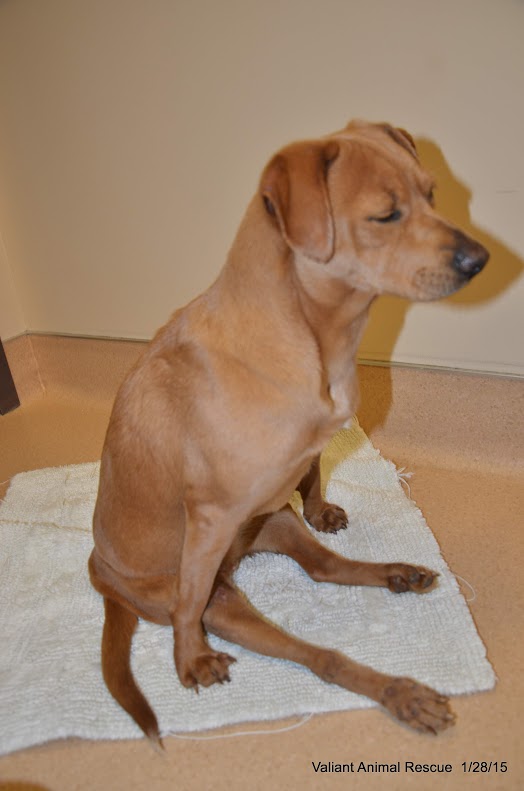MENDING MOLLY The story of one dog’s perseverance and grace

Michelle Reid is used to seeing the unspeakable. After years of doing animal forensics work for animal cruelty and neglect situations with her organization Valiant Animal Rescue & Relief, very little surprises her these days. But an encounter that she had with an animal in desperate need late one afternoon last winter still to this day makes her shake her head in bewilderment.
Traveling down a dusty road with law enforcement in a rural community in the upstate of South Carolina, Michelle spotted a small dog dragging its hind legs. They had to stop the car. The dog was literally dragging itself around. Unfortunately, it was late afternoon and this was not a safe area. A man appeared from a single wide trailer who claimed that the dog was his. He scooped the dog up and started to walk away. Michelle noticed several things, including burns on the dog’s legs and a horrible stench of urine that was coming from the animal. The situation was clearly not normal and Michelle’s intuition and observations wouldn’t let up. She would be back. But her vast experience dealing with situations like these has made her realize… the better understanding you have of a situation, the more evidence and documentation you collect, the better the result will be if you end up in court. Who was this guy and what else was happening here? She had to find out.
Michelle explains that the priority is always keeping an animal out of a dangerous situation. But if you don’t have clear evidence that the animal is in immediate danger, or it appears that an animal has sustained long-term neglect, the evidence gathering process can be critical to achieving success in court.
Michelle talked that evening to informants she had in the community – a place she was familiar with – and found out that another man had been bragging about hitting the dog in its back with a wooden board a few months before, in an attempt to keep it from barking when he was breaking into a shed. This man – and the dog’s current owners – both had a history of drug charges. Michelle knew that this community had a reputation for its gangs and drug users, further demonstrated by the fact that she actually stepped over a hypodermic needle when she first got out of the vehicle to see the dog.
With the early sunrise the next morning Michelle was back, this time with another officer to perform a welfare check. Walking up the stairs and onto the porch of the trailer, the smell of feces fumed from behind stacked plywood. With a knock and opening of the door, the dog and three people came out of the trailer, the man from the day before, a woman and an older man who was clearly intoxicated. As Michelle questioned the woman about why the dog had not received medical attention, one excuse after another was delivered – no access to a car, no money, etc. The woman had open lesions all over her face, arms and legs. Michelle recognized another smell, this time of meth. Immediately, Michelle and the officer requested that everyone walk away from the house.
Her quick thinking also told her to put on gloves, grab the dog and wrap it in a towel. Meth exposure is no joke; when it is smoked it creates a residue that is heavier than air particles and it tends to fall and stick to things. Because animals are close to the ground, they are easily exposed. It can be absorbed through the skin or when a dog goes to lick its feet.
Michelle called a local agency to request use of their utility sink to decontaminate the dog. Knowing that every minute was critical, Michelle informed the woman owner that her only option was to surrender the dog. While it wouldn’t prevent potential charges for animal cruelty, surrendering the dog would be a good faith effort and important step to getting it the immediate help it needed.
Michelle drove to the facility to bathe the dog, having to drive with the windows down because of the toxic and noxious smell. Three baths were required (as were heavy duty rubber gloves!). On the way back to town, the dog kept acting agitated, twitching with repetitive movements. These were clearly signs that reaffirmed meth exposure.
Once back in Charleston, the first stop was the emergency veterinarian where she was further evaluated. There, the dog was put on iv’s and received other supportive treatment. Everyone – Michelle and the veterinarians -- were concerned about her ability to live through the night, after all, no-one knew exactly the length of time of her exposure to the meth or the degree of severity of her other injuries. She was given the name “Molly.”
It was also discovered that Molly had tons of internal parasites and an awful urinary tract infection where an abundance of crystals were found in her urine. This was also very painful for her.
It took a few days to get Molly in stable condition, and she was given x-rays and a CT scan to see the extent of Molly’s injuries to her back and spinal cord. A piece of her vertebrae had been broken and was actually lodged into her spinal cord. She wasn’t able to use her back legs at all, but responded with a jerk when her toes were pinched. This gave everyone some hope that surgery could help her condition. The neurologist felt that there was hope that Molly could walk again following corrective spinal surgery.
A week later, Molly received surgery. Following her surgery, \Molly had to stay for another stint at the emergency hospital for her recovery. Michelle put a plea out online to find a doggie wheelchair and someone graciously responded to the need. Molly would need to stay as much as possible in an upright position and slowly gain strength in her back leg where she had absolutely no muscle mass and her legs at started to atrophy.
Molly was brought home and for weeks Michelle worked with her in the wheelchair cart as well as took her took physical therapy. Michelle also spent a lot of time sling walking Molly to help her balance and get the walking motions back. Once the incision healed and her staples were removed, Molly was able to start water therapy. She was also given acupuncture treatments. Throughout all of this Molly remained sweet, determined and incredibly thankful for the love, attention and care that she was finally receiving. She never gave up.
Slowly but surely Molly started standing and balancing on her own, and in the coming months she would start using her back legs again! Today, Molly has started to walk and can now even do it without a wheelchair. She has been moved into a very loving foster home on Daniel Island where she has two doggie foster siblings and lots of interaction with children that love her.
Molly’s story is one of perseverance and grace. She was rescued from an unfair situation of extreme pain and neglect and had to endure months of difficult therapy, but she never gave up. And through it all, she loved everyone she came into contact with, showing her appreciation in every way she could.
The investigation and case around Molly’s abuse is still active and ongoing. Michelle believes strongly that it is only a short amount of time until charges will occur and justice will be served for Molly. With a litany of major animal cruelty cases won in court over the last several years, Valiant’s strong record of holding offendor’s accountable may be the best indication of what is likely to come for Molly’s abusers.
There are unfortunately countless situations of animal cruelty and neglect in communities across our state. Valiant, a nonprofit 501(c)(3) works tirelessly to stop animal cruelty at the source by consulting on and often managing difficult cases of animal abuse and neglect throughout the Carolina’s. Valiant’s website – where you can learn more about Michelle’s cases -- is www.valiantanimalrescue.org.
You can support their amazing work and help fund cases like Molly’s by visiting paypal.me/valiantrescue or send donations to:
P.O. Box 13477
Charleston, SC 29422




